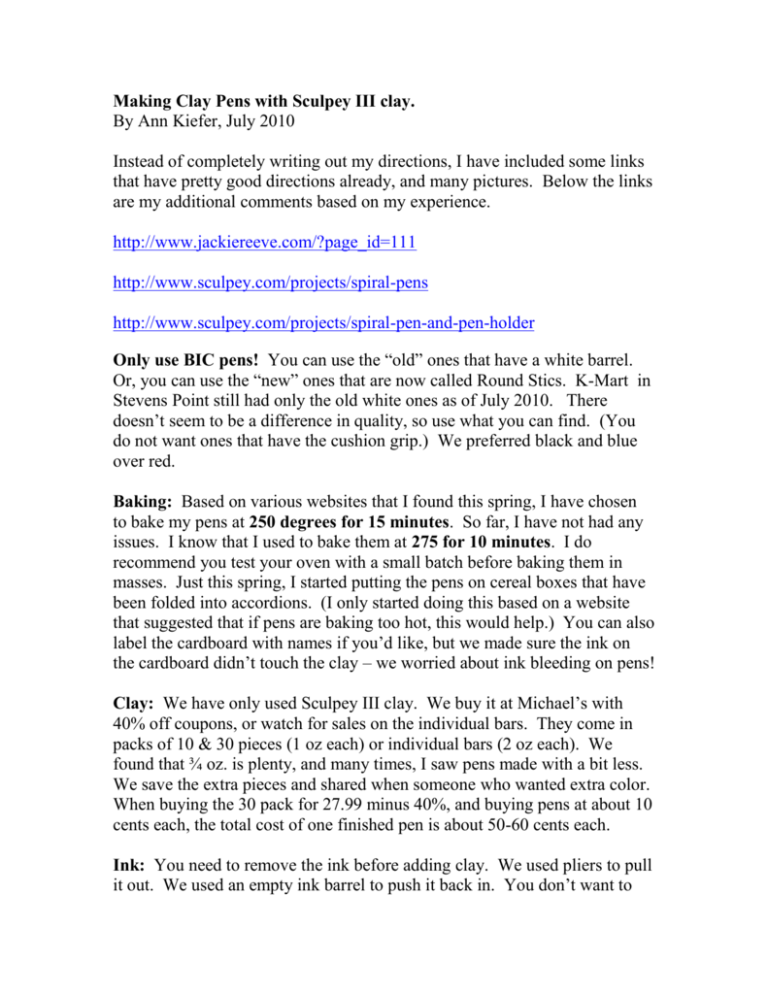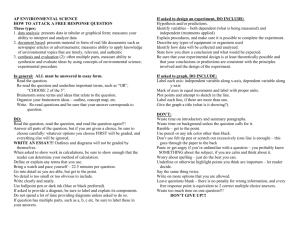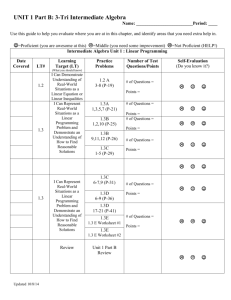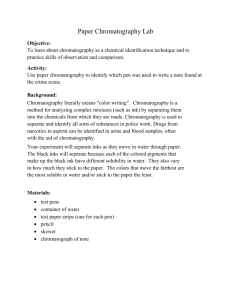save
advertisement

Making Clay Pens with Sculpey III clay. By Ann Kiefer, July 2010 Instead of completely writing out my directions, I have included some links that have pretty good directions already, and many pictures. Below the links are my additional comments based on my experience. http://www.jackiereeve.com/?page_id=111 http://www.sculpey.com/projects/spiral-pens http://www.sculpey.com/projects/spiral-pen-and-pen-holder Only use BIC pens! You can use the “old” ones that have a white barrel. Or, you can use the “new” ones that are now called Round Stics. K-Mart in Stevens Point still had only the old white ones as of July 2010. There doesn’t seem to be a difference in quality, so use what you can find. (You do not want ones that have the cushion grip.) We preferred black and blue over red. Baking: Based on various websites that I found this spring, I have chosen to bake my pens at 250 degrees for 15 minutes. So far, I have not had any issues. I know that I used to bake them at 275 for 10 minutes. I do recommend you test your oven with a small batch before baking them in masses. Just this spring, I started putting the pens on cereal boxes that have been folded into accordions. (I only started doing this based on a website that suggested that if pens are baking too hot, this would help.) You can also label the cardboard with names if you’d like, but we made sure the ink on the cardboard didn’t touch the clay – we worried about ink bleeding on pens! Clay: We have only used Sculpey III clay. We buy it at Michael’s with 40% off coupons, or watch for sales on the individual bars. They come in packs of 10 & 30 pieces (1 oz each) or individual bars (2 oz each). We found that ¾ oz. is plenty, and many times, I saw pens made with a bit less. We save the extra pieces and shared when someone who wanted extra color. When buying the 30 pack for 27.99 minus 40%, and buying pens at about 10 cents each, the total cost of one finished pen is about 50-60 cents each. Ink: You need to remove the ink before adding clay. We used pliers to pull it out. We used an empty ink barrel to push it back in. You don’t want to push the ink on a hard surface or you may ruin the ball at the end. We labeled the barrel we used because it changed shape at the end and we only wanted to use it for pushing ink back in. Rolling & Smoothing: If you roll the pens too hard while forming, the clay may come away from the pen and create an air pocket. Gently squeeze it back on and it will stick again. Encourage gentle rolling and you’ll avoid this most of the time. Pen Styles: (names below are what we called them to distinguish) The easiest ones to make are what we call tie-dye. If you take three ¼ oz pieces, makes snakes, twist them together, make a snake and twist it into itself several times, flatten and put around the pen, you will have a tie-dye effect. (You don’t have to flatten it ahead of time.) Camouflage: Same as tie-dye except you twist it less number of times – bigger spots on the pen look like camouflage, especially if you use such colors. Spirals – a bit more difficult to make, but very cool. Don’t worry if you don’t get them perfect, they still make a great pen. See last two links above for example. Design on solid: This one is a good way to make a small amount of favorite color to go a long way, or a great way to use up a least favorite color. Using about ½ oz, cover a pen with one color. (Make a snake, wrap it around, and smooth it out.) Using a 2nd color, and really you will need less than ¼ oz, make skinny snakes, and press it into either a long stripe and wrap it around (or press the snake directly into the pen), or make unique shapes with the skinny snake before adding it to the pen. When you press a skinny shape into a pen, it spreads out when rolled onto the pen. Keep this in mind if you want something delicate. Stripes: Make snakes of different colors, roll them onto the pen (leaving space because they’ll spread), and roll them smooth. Mixing colors – I had a rule with my 1st and 2nd graders that they could blend and mix the clay as much as they wanted, but that I needed to see the distinct colors. If you want a specific color, go ahead and blend until you have it, but this was my way of telling young kids to avoid making an unintended brown! The sky is the limit – we’re still creating new ways of making these, and kids of all ages (including adults) have find squishing the clay, playing with color schemes and having a pen to use as a final product. They do BREAK if dropped! Handle with care. I’ve had some on my desk at work that have run out of ink without breaking. I’ve also seen one come out of the oven, dropped 20 minutes later and cracked! I’ve also seen some pens that just have too much clay at the non-ink end tend to break apart easily. Therefore, I’ve asked students to keep the shape standard and not add extra clay. If you have questions, please let me know! I’d be happy to help as best as I can. I’m not an expert by any means, but I’ve had hours of fun both at home on my own family, with a class of 15 1st and 2nd graders, and several children at church.




